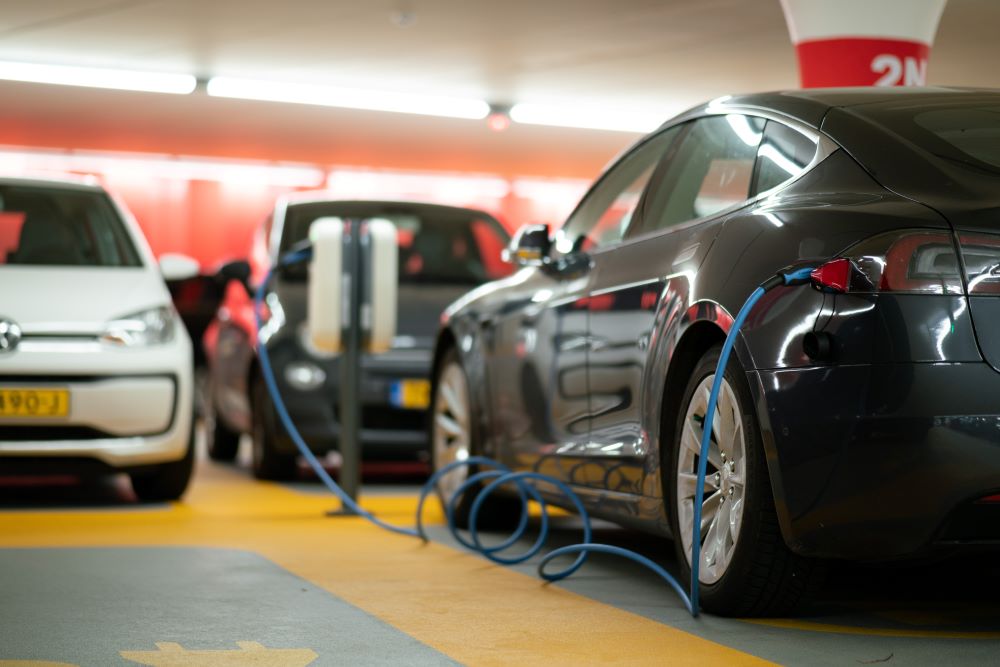In this interview, we talked to Matt Smith, Senior Director of Grid Management at Itron. He explained why climate change is affecting electrical systems and how technology, such as Distributed Intelligence (DI) can help grids become more resilient. One way of providing backup power during outages is with the energy stored in Electric Vehicle (EV) batteries, something Matt and his team did during an outage when Hurricane Ian hit Florida.

Matt Smith, Senior Director of Grid Management
Matt has thirty years of experience across the home computer and consumer electronics industries. He is now tapping into that extensive knowledge to set the global business and product strategy for Itron’s network platform line-of-business. The company has a long experience of providing technology that helps complex utility systems run smoothly and without interruption. As Matt related:
“Itron enables utilities and cities to safely, securely and reliably deliver critical infrastructure solutions to communities in more than 100 countries. Our portfolio of smart networks, software, services, meters and sensors helps our customers better manage electricity, gas and water resources for the people they serve. By working with our customers to ensure their success, we help improve the quality of life, ensure safety and promote the well-being of millions of people across the globe. Itron is dedicated to creating a more resourceful world.”
Because climate change is a growing threat, Itron is focused on developing solutions that create reliable, resilient electrical infrastructure better able to cope with storms.
How Climate Change Affects Electrical Systems
Electrical systems are particularly affected by climate change because extreme weather events such as storms, floods, heatwaves, and ice-storms create widespread damage and disruption. Matt described the nature of the problem for electrical grids, noting some of the major issues:
“Climate change is driving extreme weather events across the globe, which are wreaking havoc on the aging U.S. power grid. Natural disasters such as major hurricanes, heatwaves and unexpected cold can damage or stress critical infrastructure, including power lines, transformers and substations. These impacts can lead to outages that may last for weeks, as the grid is overloaded and cascading failures occur. As climate change worsens, natural disasters will become more frequent, putting massive strain on the power grid.”
For companies like Itron, helping electrical systems and utilities prevent and mitigate damage from extreme weather is deeply embedded in their technology.
Preventing and Mitigating Damage from Natural Disasters
We are used to the traditional model for electricity, where huge generation plants send electricity down transmission lines before distribution to homes and business through the familiar overhead and underground cables. Now, this centralised model is shifting towards decentralised systems that incorporate distributed generation resources, including renewable energy, closer to where power is needed.
These flexible, interconnected grids form the grid edge, where new technologies manage electricity from local resources and feed it into the grid. The systems designed to monitor and manage these complex power flows also make the grid more resilient and able to recover from damage. Matt explained why Itron’s grid edge technological solutions are important:
“Intelligent grid edge solutions, such as distributed intelligence (DI) platforms, can detect anomalies, sectionalize the energy grid, reroute power and minimize outages. Without modernized infrastructure, utilities cannot identify the root cause of outages quickly or efficiently. Crews must manually evaluate power lines, which can take days or even weeks, while they deal with the aftermath of the natural disaster. DI technology provides real-time data that helps utilities support grid resilience in times of need.”
In the face of a changing climate, advanced metering infrastructure (AMI), big data, and high-speed communications help utilities use DI to view the grid in real time. The systems can react to problems much more quickly and restore power to the highest number of people in the shortest time. One way of providing localised supply during an outage is by using the energy stored in electric vehicle batteries for backup power.
How Can EV Storage Support Electrical Grids During Outages
For a few years, providers of grid edge technology and electric utilities have explored how they can use the energy stored within EV batteries to provide power during an outage. Sometimes, this can be simply feeding electricity back into the grid, but using them as a mobile resource can provide power where it is most needed. Matt gave a description of the process:
“All EVs have the capacity to provide backup and emergency power when outages occur but heavy-duty Battery Electric Vehicles (BEVs) like school buses and municipal transit buses have the most impact. With their very large battery packs, they can be used as a mobile energy source during significant events. When power is lost due to weather or other emergencies, buses can be driven to locations to support critical services such as shelters and hospitals, providing an additional power source to supplement existing resources that may not be able to last as long as needed during the outage.”
Using EV batteries for power proved its value in 2022, when Matt and his team actually used them to keep the lights on during Hurricane Ian.
Keeping the Lights on During Hurricane Ian
On September 28–29, 2022, Hurricane Ian landed on the shores of Florida as one of the most powerful storms ever to hit the state. The storm picked up more power as it travelled onshore, hitting the coastline with an unpredicted intensity that heavily damaged infrastructure. With high winds, storm surges, and very heavy rain, Ian knocked out large swathes of the power grid, affecting millions of people. Matt and his team were present in Florida at the time and turned to EV batteries as a source of emergency power.
“The team was packing up from the Itron Inspire 2022 conference when Hurricane Ian struck Florida, near the area where the event was held. The strong winds and heavy rain from the hurricane caused a power outage, but luckily enough, there were smart streetlights available from a nearby demo booth. By connecting to an on-site electric vehicle (EV), the smart streetlights were able to leverage the stored battery power to illuminate the conference room. The team sheltered in a place with power.”
Funding and Grants to Support the Technology
While many utilities are hardening their systems with stronger poles, burying cables underground, and trimming overhanging trees, these are not enough on their own. Increasingly, utilities are installing flexible, decentralised systems, which provide resilience and help them cope with the increased power demand for the growing number of electric vehicles. While there is funding available to help utilities upgrade their systems to support EV and adopt DI technology, Matt pointed out that they are not always aware of this:
“The Infrastructure Investment and Jobs Act (IIJA), which was signed into law by President Biden in November 2021, is a monumental step towards rejuvenating America’s energy infrastructure. It has awarded nearly $185 billion to more than 6,900 energy programs, with funding that continues to be awarded today. This legislation funds grants and grid modernization programs that support grid sustainability and EV adoption. However, many utilities are not aware of the opportunity or their eligibility to apply. A recent survey found that 96% of utilities say their state commissions have not informed them of the funding opportunities provided by the IIJA.”
Distributed Intelligence and Electric Vehicles
Many electric utilities are facing demands to develop EV charging infrastructure while mitigating the growing threats from extreme weather events. They need to modernise their systems and create decentralised, resilient grids that can react quickly with the use of intelligent grid edge technology. With the right distributed intelligence, systems will be able to cope with increased demand while minimising disruption and outages. As Matt noted:
“Natural disasters are becoming more frequent, but that is not the only challenge the aging power grid faces. EV adoption is growing, particularly as standards are proposed to dramatically speed up the energy transition. In order to properly prepare for the growth in EV adoption and meet demand, utilities must ensure that the grid is reliable and resilient. Things such as DI must be leveraged to prepare for the significant strain on the infrastructure.”
Photo credits:
Photo by Michael Fousert on Unsplash







